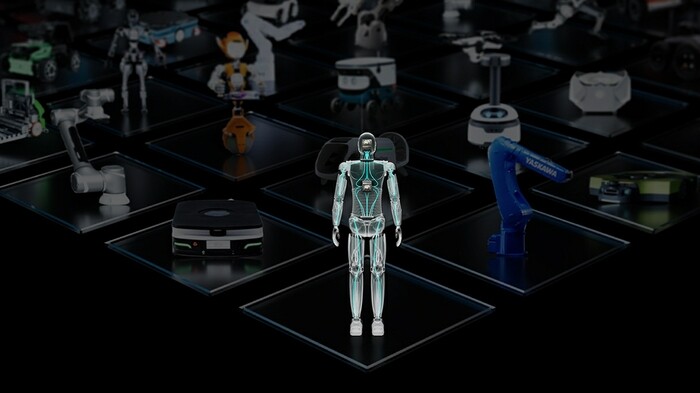
The Robotics Roundup is a weekly newspost going over some of the most exciting developments in robotics over the past week.
In today’s edition we have:
- NVIDIA Announces Project GR00T Foundation Model for Humanoid Robots and Major Isaac Robotics Platform Update
- How Zipline Designed Its Droid Delivery System
- Drones and robots could replace some field workers as farming goes high-tech
- A skating, tri-pedal robot capable of highly stable locomotion
- The Ugandan adventures of two hyper-realistic biorobots
NVIDIA Announces Project GR00T Foundation Model for Humanoid Robots and Major Isaac Robotics Platform Update
NVIDIA has announced Project GR00T, a multimodal foundation model designed for humanoid robots. As part of the initiative, NVIDIA also unveiled a new computer, Jetson Thor, and upgrades to the NVIDIA Isaac robotics platform. GR00T (Generalist Robot 00 Technology) will enable robots to understand natural language and learn tasks by observing human actions. Jetson Thor, a computer specifically created for humanoid robots, is designed for performing complex tasks and interacting with people and machines. Partnering with major humanoid robot companies, NVIDIA is building a comprehensive AI platform. The updated Isaac platform facilitates the creation of new foundation models for any robot embodiment in any environment. It includes Isaac Lab for reinforcement learning, OSMO for workload coordination, and Isaac Manipulator and Isaac Perceptor, offering pretrained models and reference hardware for various robotic functions.
How Zipline Designed Its Droid Delivery System
Zipline has developed a complex but effective package delivery system that combines a large drone (the Zip) with a smaller, package-delivering “Droid”. The Droid, which can carry a 2.5-3.5 kilogram payload, is lowered on a tether from the Zip and uses thrusters and sensors to navigate to a delivery area just one meter in diameter. After payload delivery, the Droid ascends back to the Zip. The design of the Droid was inspired by sea mammals and is intended to be both functional and aesthetically pleasing. The system has a service radius of about 16 kilometers, can operate in numerous weather conditions, and can make deliveries to any outdoor space. Zipline’s new delivery method is set to launch later this year, and partnerships are already in place for residential deliveries with various organizations including Cleveland Clinic, WellSpan Health, Mendocino Farms, and Walmart.
Drones and robots could replace some field workers as farming goes high-tech
Hylio, a technology company based in Houston, has been granted an exemption by the Federal Aviation Administration to operate swarms of heavy drones for agricultural purposes. The drones, some of which weigh up to 400 pounds, can distribute fertilizer and pesticides over fields, a task traditionally performed by workers or planes. The February 2024 World Agriculture Expo showcased various high-tech agricultural tools including autonomous crop sprayers and AI-powered robots used for picking berries. Ethan Rublee’s company farm-ng demonstrated an all-electric, robotic micro-tractor named the Amiga, capable of performing various tasks autonomously. Carbon Robotics’ Laser Weeder, which uses infrared lasers and high-speed cameras to identify and destroy weeds, was also presented. While these high-tech tools could help alleviate the long-standing labor shortage in US agriculture, there are concerns about the potential job loss implications for farm workers. The US Department of Labor is preparing recommendations for an aid program to assist farm workers displaced by AI, to be presented to President Biden.
A skating, tri-pedal robot capable of highly stable locomotion
Researchers at the University of Michigan have developed a tri-pedal skating robot named SKOOTR that exhibits higher stability compared to other three-legged robots. The inspiration for SKOOTR came from the omnidirectional maneuverability exhibited by rolling office chairs and swimming brittle stars, combining the versatility of legged robots with the maneuverability of a ball-bot. Constructed using a 3D printer, SKOOTR comprises a large central sphere, a hub housing the electronics, and three legs, each with a hybrid contact mode at the tip. These legs can switch between a passively rolling caster and a rubber foot. The central sphere is interchangeable, allowing for customization based on user needs. SKOOTR demonstrates remarkable stability and is capable of overcoming obstacles, including stairs, while maintaining balance. The developers plan to further explore the benefits of radial symmetry in robots and test SKOOTR in real-world applications.
The Ugandan adventures of two hyper-realistic biorobots
In a collaboration with the British Broadcasting Corporation (BBC), Switzerland’s École Polytechnique Fédérale de Lausanne’s BioRobotics Lab (BioRob) has developed two lifelike robots, SpyCroc and SpyLizard, designed to mimic a crocodile and a monitor lizard respectively. These robots were tested in Uganda where they had to adapt to challenges such as harsh climate and rugged terrain, leading to improvements in their weight allocation and operational strategies. Despite the difficulties, the robots provided invaluable insights which led to the creation of the more robust, flexible, and waterproof Krock-2 platform. Going forward, BioRob is looking to integrate robotics and neuroscience to develop tactile skin with sensors. In addition, they aim to democratize access to bio-inspired platforms to foster interdisciplinary collaboration and drive scientific progress.


